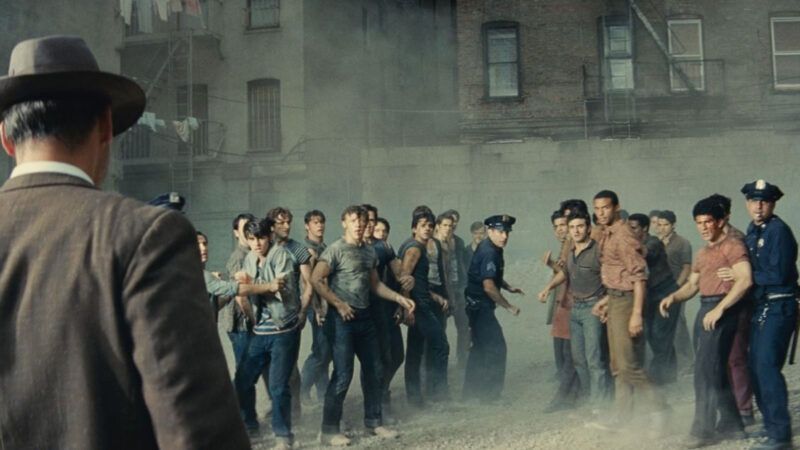Steven Spielberg's West Side Story Is a Dazzling Bit of Americana
It’s a moving story about immigration and assimilation, and one of the best movies of the year.

On first glance, West Side Story might seem a strange project for Steven Spielberg: The director, better known for adventure films and serious historical dramas, has never made a musical. Robert Wise's 1961 film version, adapted from the 1957 Broadway show, is a popular classic in good standing, not an outdated clunker in need of update. Wasn't Spielberg supposed to be making another Indiana Jones?
But look a little further, and it's clear that West Side Story is an almost perfect fit for Spielberg's longstanding interests and predilections: It's a beloved, exuberant, tragic-yet-hopeful story of volatile young men, cyclical violence, and the sort of ethnopolitical culture clash that has defined the American project. It's a story about the formation of post-war American identity, about immigration, assimilation, and community, told through song, dance, romance, and cathartic violence. Spielberg is, among other things, Hollywood's foremost purveyor of pop Americana, obsessed with national myth and self-image; no wonder he couldn't resist. And for that, we are fortunate. Spielberg's West Side Story is a marvelous movie, bursting with life and vitality. It is one of the very best movies of the year.
Of course, it's not just Spielberg's movie: Although the film keeps the lush Leonard Bernstein music and the lyrics by recently deceased Broadway legend Stephen Sondheim, Spielberg's remake updates the book with new dialogue from Tony Kushner. Kushner, notably, is the playwright behind Angels in America, but he's also the writer of Spielberg's Munich and Lincoln, and many of the themes from those movies emerge here.
As in Munich, Spielberg and Kushner frame West Side Story as a tale of ethno-political cyclical conflict. In this case, the war is between the Sharks, a gang of Puerto Rican immigrants, and the Jets, a white ethnic gang described by a local police officer as "the last of the can't-make-it Caucasians." The rival gangs are fighting over the same slice of New York territory, a decrepit but joyful immigrant neighborhood that's already being torn down to make way for more upscale dwellings. They don't know much about each other, but they know enough—as Jets leader Riff (a feisty, rousing Mike Faist) says, "They. Ain't. Us."
Kushner's book is grittier than the original without ever becoming needlessly grim; his characters still talk in a stagey, rhythmic patter, one that seems musical even when there's no orchestral accompaniment. The accompaniment, however, remains one of the highlights of the show: Bernstein's moody, jazzy, big-band score has stayed a staple of high school marching bands for decades for a reason: Even when it's played badly, it still sounds pretty good—and here it's played and recorded exceptionally well.
The songs are catchy and memorable with big hooks, but they're not just throwaway earworms. And often enough, the music holds its own, with long, wordless sequences where the characters neither sing nor speak. The music is simply the sound of them going about their lives.
The song and dance numbers, meanwhile, are as memorably spectacular as you might hope from the single greatest director of movie setpieces in Hollywood history. Spielberg deserves this accolade without reservation or qualification: From Jaws to Raiders of the Lost Ark to Jurassic Park to Saving Private Ryan to War of the Worlds, Spielberg is the reigning master of ambitious cinematic sequence design; no director is better at creating instantly memorable, perfectly iconic imagery in sequence. If you are an American adult who has ever been to the movies, you can almost certainly call to mind at least one defining image from a Spielberg movie; more likely, you can think of a dozen. He has crafted too many universal cinematic reference points to count.
In West Side Story, Spielberg doesn't stage anything too overtly showy or grandiose; in some ways, the production feels small, almost intimate. But that just makes the sheer enthralling beauty of his shots more impressive. There's never been another director who is better at lighting and framing human bodies (and sometimes cars, trucks, tanks, dinosaurs, and spaceships) in motion, whether that motion is running or punching or dancing. West Side Story's breathtaking use of light, color, shadow, and tightly choreographed camera movement to convey meaning merely makes the case for his greatness yet again.
Indeed, even though West Side Story is Spielberg's first true musical, it feels like he's been directing them forever, and perhaps even like he invented the form—or as if he's inventing it as we watch. And as the movie plays out, it also becomes clear that, in some sense, he's always been making musicals, or at least that his intricately designed setpieces have always had a kind of Broadway musical influence to them: Think of the diamond MacGuffin hunt that kicks off Indiana Jones and the Temple of Doom, or the car factory chase in Minority Report, or even the T-Rex attack in the middle of Jurassic Park.
No one breaks out in song (though it's not too hard to imagine the T-Rex turning to the camera and belting out a showstopper about her rage and hunger). But these big numbers are constructed at least in part from the elements of musical theater. They are all mechanized motion, complex choreography, animalistic desire, the logic of action and reaction timed and sequenced to sound and music, with slow builds and big payoffs, and characters in crisis, fighting for their lives and their identities, telling you, any way they can, what they feel and who they really are. At their best, those sequences can be transcendent, thrilling, joyful, funny, frightening, moving, sometimes all at once. West Side Story is all of these, because it's Spielberg at his best.


Show Comments (70)